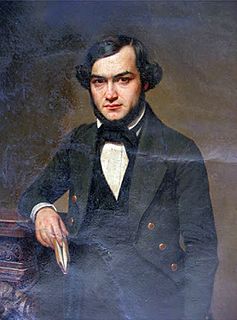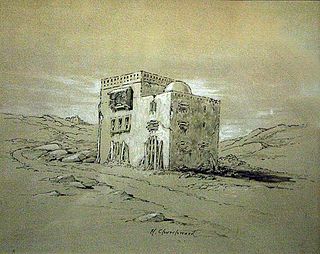
Victor-Marie Hugo was a French poet, novelist, essayist, playwright, and dramatist of the Romantic movement. During a literary career that spanned more than sixty years, he wrote abundantly in an exceptional variety of genres: lyrics, satires, epics, philosophical poems, epigrams, novels, history, critical essays, political speeches, funeral orations, diaries, and letters public and private, as well as dramas in verse and prose.

Pierre Jules Théophile Gautier was a French poet, dramatist, novelist, journalist, and art and literary critic.

Charles Augustin Sainte-Beuve was a French literary critic.

Joseph Autran was a French poet.

André Caplet was a French composer and conductor now known primarily through his orchestrations of works by Claude Debussy.
La Légende des siècles is a collection of poems by Victor Hugo, conceived as an immense depiction of the history and evolution of humanity.

19th-century French literature concerns the developments in French literature during a dynamic period in French history that saw the rise of Democracy and the fitful end of Monarchy and Empire. The period covered spans the following political regimes: Napoleon Bonaparte's Consulate (1799–1804) and Empire (1804–1814), the Restoration under Louis XVIII and Charles X (1814–1830), the July Monarchy under Louis Philippe d'Orléans (1830–1848), the Second Republic (1848–1852), the Second Empire under Napoleon III (1852–1871), and the first decades of the Third Republic (1871–1940).

Francis Jammes was a French and European poet. He spent most of his life in his native region of Béarn and the Basque Country and his poems are known for their lyricism and for singing the pleasures of a humble country life. His later poetry remained lyrical, but also included a strong religious element brought on by his (re)conversion to Catholicism in 1905.
Odes et Ballades, published in 1828, is the most complete version of a collection of poems by Victor Hugo written and published between 1822 and 1828. It includes five books of odes and one book of ballads.

Mal du siècle is a term used to refer to the ennui, disillusionment, and melancholy experienced by primarily young adults of Europe's early 19th century, when speaking in terms of the rising Romantic movement. François-René de Chateaubriand's protagonist René characterizes the Romantic ennui that would become a benchmark of the Romantic esthetic in the first half of the century:
René is a young man who was suffering from the moral malady known as "le mal du siècle". This was an "état d'âme" that was not uncommon during the first half of the nineteenth century, and that was often copied and idealized in literature. It was largely boredom. Other manifestations were: melancholy of an aristocratic type, precocious apathy, discouragement without cause, distaste for living. The will seemed paralyzed by the contemplation of life's struggle. Faith and a sense of duty were alike absent. Man was "possédé, tourmenté par le démon de son cœur." Morbid sadness was mistaken for the suffering of a proud and superior mind. There was in it all a certain "bonheur d'être triste" which attracted. This pessimistic state was analyzed in René with great subtlety and penetration. The hero was made a most original and living type, a type that was repeated in the Childe Harold and Manfred of Byron, and even, in some of its manifestations, in the Hernani of Victor Hugo. In the opinion of Chateaubriand, René was his masterpiece. Later judgments regarding it are not unanimous, but many authoritative French critics see in it one of the masterpieces of their literature.
Charles Brifaut was a French poet, journalist, publicist and playwright.
Les Rayons et les Ombres is a collection of forty-four poems by Victor Hugo, the last collection to be published before his exile, and containing most of his poems from between 1837 and 1840.

André Fontainas (1865–1948) was a Belgian Symbolist poet and critic. He was born in Brussels. He spent much of his life in France. He taught at Lycee Fontaines. He was a member of the Académie Mallarmé.
Jean-Claude Pirotte was a Belgian writer, poet and painter. A French language writer, his 2006 novel, Une adolescence en Gueldre, won the Prix des Deux Magots.

Les Feuilles d'Automne is a collection of poems written by Victor Hugo, and published in 1831. It contains a multitude of poems, six of which are especially known as Soleils Couchants.

Pierre Pélissier was a pioneer for deaf education in France in the mid 19th century. He was born September 22, 1814, in Gourdon, Lot, and died April 30, 1863. He was a teacher of the deaf and also wrote a dictionary for an early form of French Sign Language in 1856. He studied first at Rodez and Toulouse, under Abbot Chazottes. He then became a teacher at the School of the Deaf in Toulouse. He was the deputy secretary of the Central Society for Deaf Mutes in Paris in 1842. At 29, in 1843, he went to Paris to teach at the Imperial School for Deaf Mutes, until his death.

Paul-Napoléon Roinard was a French anarchist poet.
Françoise Lefèvre is a French writer discovered by publisher Jean-Jacques Pauvert. She is a recipient of the Grand prix des lectrices de Elle

Les Djinns is one of the most famous poems of French author Victor Hugo, published in 1829 in his collection Les Orientales.

Anaïs Ségalas, born Anne Caroline Menard was a French playwright, poet and novelist. She was a member of Société La Voix des Femmes in Paris in 1848 and of other Parisian feminist organizations.